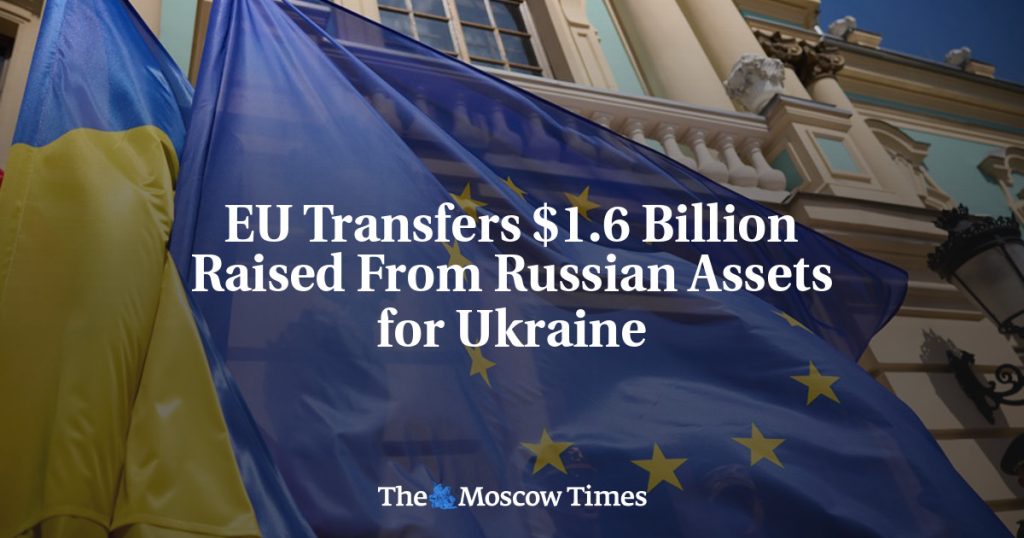The European Union recently announced that they have made 1.5 billion euros available to support Ukraine, the first portion of funds generated from profits on frozen Russian assets. Back in May, EU member states had agreed to allocate billions of euros in profits from frozen Russian Central Bank assets to help arm Ukraine and fund its reconstruction efforts post-war. The EU had frozen approximately 200 billion euros of Russian Central Bank assets held in the bloc as part of sanctions imposed on Moscow due to its invasion of Ukraine in 2022. The majority of the frozen funds in the EU are held by a Belgium-based international deposit organization, Euroclear.
EU Chief Ursula von der Leyen emphasized the EU’s commitment to stand with Ukraine by transferring the 1.5 billion euros in proceeds from the immobilized Russian assets to support Ukraine’s defense and reconstruction efforts. She highlighted that there is no better use for the Kremlin’s money than to make Ukraine and all of Europe a safer place to live. The funds come from the interest generated from the frozen Russian funds, rather than the funds themselves, which are still locked away from Moscow. The EU stated that 90% of the money would go to the European Peace Facility, a central fund used to pay for arms for Ukraine, while the remaining 10% would be allocated to the EU’s separate Ukraine Facility to support the country’s reconstruction needs.
Ukrainian Prime Minister Denys Shmyhal expressed gratitude towards the EU for their support and significant contribution to Ukraine’s defense and reconstruction efforts. The Ukrainian defense ministry also welcomed the transfer, stating that it will help strengthen their defense capabilities. However, Russia condemned the move, calling it illegal. Dmitry Peskov, Russian President Vladimir Putin’s spokesman, raised concerns about the EU’s decision and suggested that it would lead to thoughtful actions in response to what they perceive as illegal decisions being implemented by the European Union.
The move by the EU to support Ukraine with 1.5 billion euros from profits on frozen Russian assets signifies a significant step in aiding Ukraine’s defense and reconstruction efforts following the invasion by Russia in 2022. This financial support from the EU will play a crucial role in helping Ukraine strengthen its defense capabilities and rebuild post-war. The allocation of funds towards the European Peace Facility and the Ukraine Facility demonstrates the EU’s commitment to supporting Ukraine in multiple aspects as it continues to recover from the conflict. Despite Russia’s opposition to the transfer of funds, the EU remains dedicated to standing by Ukraine in its time of need.
The freezing of Russian Central Bank assets and subsequent allocation of profits to support Ukraine are part of the broader sanctions imposed on Russia by the EU in response to its invasion of Ukraine. These sanctions are aimed at holding Russia accountable for its actions and providing support to Ukraine, both in terms of defense and reconstruction. The decision to use funds generated from frozen assets to assist Ukraine highlights the EU’s solidarity with the Ukrainian people and its commitment to ensuring a safer and more stable future for the country and the broader European region.
The support provided by the EU to Ukraine through the transfer of funds from frozen Russian assets is a crucial step in helping Ukraine recover from the devastating impact of the conflict. By allocating these funds to Ukraine’s defense and reconstruction efforts, the EU is not only providing financial assistance but also sending a strong message of solidarity with Ukraine and a clear stance against Russian aggression. As Ukraine continues to rebuild and strengthen its defense capabilities, the EU’s support will be instrumental in contributing to the country’s recovery and creating a more secure environment for the Ukrainian people and the region as a whole.


